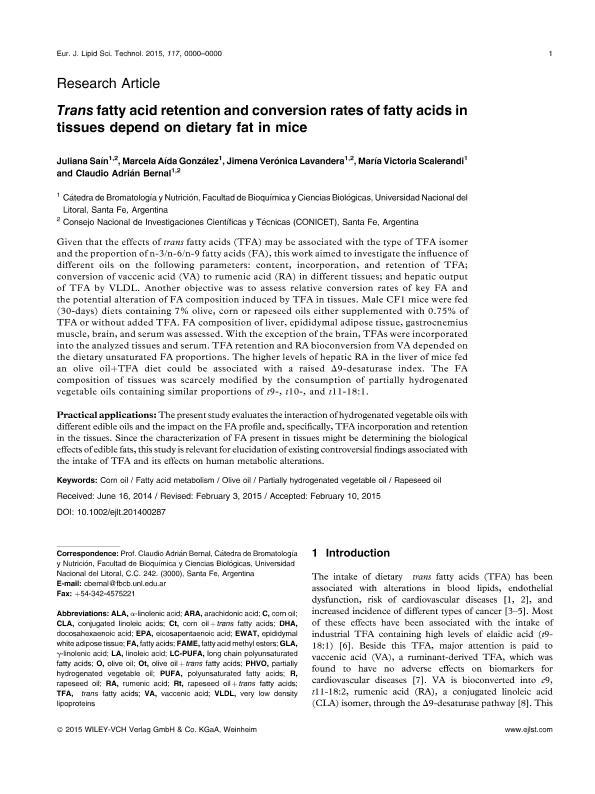Mostrar el registro sencillo del ítem
dc.contributor.author
Sain, Juliana

dc.contributor.author
González, Marcela Aída

dc.contributor.author
Lavandera, Jimena Veronica

dc.contributor.author
Scalerandi, María Victoria

dc.contributor.author
Bernal, Claudio Adrian

dc.date.available
2018-05-09T20:33:38Z
dc.date.issued
2015-08
dc.identifier.citation
Sain, Juliana; González, Marcela Aída; Lavandera, Jimena Veronica; Scalerandi, María Victoria; Bernal, Claudio Adrian; Trans fatty acid retention and conversion rates of fatty acids in tissues depend on dietary fat in mice; Wiley VCH Verlag; European Journal of Lipid Science and Technology; 117; 8; 8-2015; 1146-1158
dc.identifier.issn
1438-7697
dc.identifier.uri
http://hdl.handle.net/11336/44694
dc.description.abstract
Given that the effects of trans fatty acids (TFA) may be associated with the type of TFA isomer and the proportion of n-3/n-6/n-9 fatty acids, this work aimed to investigate the influence of different oils on the following parameters: content, incorporation and retention of TFA; conversion of vaccenic acid to rumenic acid in different tissues; and hepatic output of TFA by VLDL. Another objective was to assess relative conversion rates of key fatty acids and the potential alteration of fatty acid composition induced by TFA in tissues. Male CF1 mice were fed (30-d) diets containing 7% olive, corn or rapeseed oils either supplemented with 0.75% of TFA or without added TFA. Fatty acid composition of liver, epididymal adipose tissue, gastrocnemius muscle, brain and serum was assessed. With the exception of the brain, TFA were incorporated into the analyzed tissues and serum. TFA retention and rumenic acid bioconversion from vaccenic acid depended on the dietary unsaturated fatty acid proportions. The higher levels of hepatic rumenic acid in the liver of mice fed an olive oil+TFA diet could be associated with a raised D9-desaturase index. The fatty acid composition of tissues was scarcely modified by the consumption of partially hydrogenated vegetable oils (PHVO) containing similar proportions of t9-, t10-, and t11-18:1.Practical applications: The present study evaluates the interaction of hydrogenated vegetable oils with different edible oils and the impact on the FA profile and, specifically, TFA incorporation and retention in the tissues. Since the characterization of FA present in tissues might be determining the biological effects of edible fats, this study is relevant for elucidation of existing controversial findings associated with the intake of TFA and its effects on human metabolic alterations.The levels of trans fatty acids (TFA) in a particular tissue might be related to different variables including: type and level of the dietary TFA isomer; uptake, metabolization and release from the tissue, and interference with different dietary fatty acids.
dc.format
application/pdf
dc.language.iso
eng
dc.publisher
Wiley VCH Verlag

dc.rights
info:eu-repo/semantics/openAccess
dc.rights.uri
https://creativecommons.org/licenses/by-nc-sa/2.5/ar/
dc.subject
Partially Hidrogenated Vegetable Oil
dc.subject
Corn Oil
dc.subject
Rapeseed Oil
dc.subject
Olive Oil
dc.subject
Fatty Acid Metabolism
dc.subject.classification
Otras Ciencias Biológicas

dc.subject.classification
Ciencias Biológicas

dc.subject.classification
CIENCIAS NATURALES Y EXACTAS

dc.title
Trans fatty acid retention and conversion rates of fatty acids in tissues depend on dietary fat in mice
dc.type
info:eu-repo/semantics/article
dc.type
info:ar-repo/semantics/artículo
dc.type
info:eu-repo/semantics/publishedVersion
dc.date.updated
2018-05-07T18:04:37Z
dc.journal.volume
117
dc.journal.number
8
dc.journal.pagination
1146-1158
dc.journal.pais
Alemania

dc.journal.ciudad
Weinheim
dc.description.fil
Fil: Sain, Juliana. Universidad Nacional del Litoral. Facultad de Bioquímica y Ciencias Biológicas. Departamento de Ciencias Biológicas. Cátedra de Bromatología y Nutrición; Argentina. Consejo Nacional de Investigaciones Científicas y Técnicas. Centro Científico Tecnológico Conicet - Santa Fe; Argentina
dc.description.fil
Fil: González, Marcela Aída. Universidad Nacional del Litoral. Facultad de Bioquímica y Ciencias Biológicas. Departamento de Ciencias Biológicas. Cátedra de Bromatología y Nutrición; Argentina
dc.description.fil
Fil: Lavandera, Jimena Veronica. Universidad Nacional del Litoral. Facultad de Bioquímica y Ciencias Biológicas. Departamento de Ciencias Biológicas. Cátedra de Bromatología y Nutrición; Argentina. Consejo Nacional de Investigaciones Científicas y Técnicas. Centro Científico Tecnológico Conicet - Santa Fe; Argentina
dc.description.fil
Fil: Scalerandi, María Victoria. Consejo Nacional de Investigaciones Científicas y Técnicas. Centro Científico Tecnológico Conicet - Santa Fe; Argentina. Universidad Nacional del Litoral. Facultad de Bioquímica y Ciencias Biológicas. Departamento de Ciencias Biológicas. Cátedra de Bromatología y Nutrición; Argentina
dc.description.fil
Fil: Bernal, Claudio Adrian. Consejo Nacional de Investigaciones Científicas y Técnicas. Centro Científico Tecnológico Conicet - Santa Fe; Argentina. Universidad Nacional del Litoral. Facultad de Bioquímica y Ciencias Biológicas. Departamento de Ciencias Biológicas. Cátedra de Bromatología y Nutrición; Argentina
dc.journal.title
European Journal of Lipid Science and Technology

dc.relation.alternativeid
info:eu-repo/semantics/altIdentifier/doi/https://doi.org/10.1002/ejlt.201400287
dc.relation.alternativeid
info:eu-repo/semantics/altIdentifier/url/https://onlinelibrary.wiley.com/doi/abs/10.1002/ejlt.201400287
Archivos asociados
